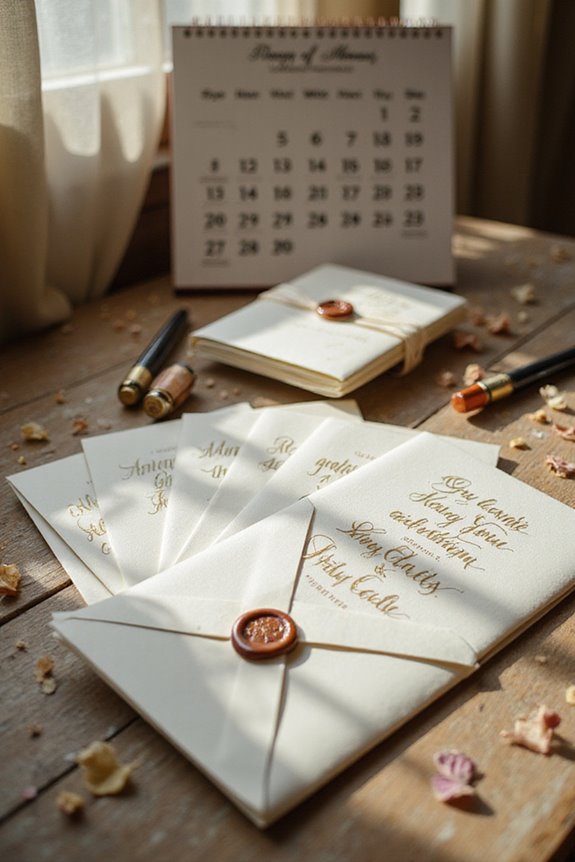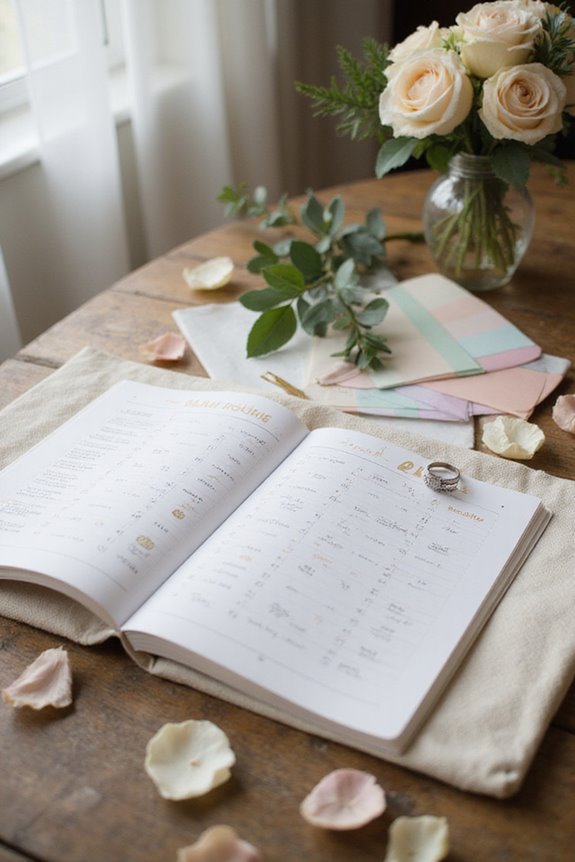When should we mail wedding invitations? Ideally, it’s best to send them out 6 to 8 weeks before the big day. If we’re having a destination wedding, aim for 12 to 15 weeks, so guests can book travel. For holiday weddings, consider mailing them 10 to 12 weeks ahead. But don’t forget to set an RSVP deadline about 3 to 4 weeks after mailing! If we play our cards right, everyone will be excited to join in the fun. And there’s more we can explore!
Key Takeaways
- Mail wedding invitations 6 to 8 weeks before the wedding day for optimal timing.
- For destination weddings, send invitations 12 to 15 weeks in advance to allow for travel arrangements.
- Holiday weddings should aim to mail invitations 10 to 12 weeks ahead to accommodate potential postal delays.
- Set RSVP deadlines 3 to 4 weeks after mailing to ensure timely responses from guests.
- Consider using priority mail to mitigate delays, especially during peak holiday seasons.
Recommended Mailing Timeline for Invitations
When it comes to mailing wedding invitations, timing is everything! We recommend sending those beautifully designed invitations about 6 to 8 weeks before your big day. This gives your guests enough time to clear their schedules and get excited about your wedding theme. If you send them too early—like more than 12 weeks—you might find guests changing their minds as plans shift. To keep things running smoothly, set your RSVP deadline for about 3 to 4 weeks after mailing. This way, we can finalize the seating chart and catering arrangements without a hitch. If you’re using QR codes for RSVPs, feel free to tighten that timeline a bit. Remember, a well-timed invitation is key to a joyful celebration!
Extended Timeline for Different Wedding Types
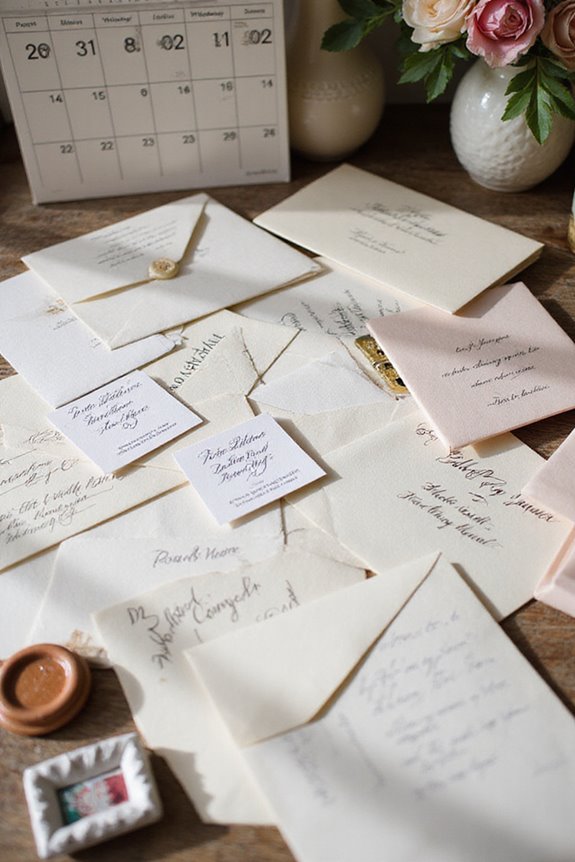
Planning a wedding is a whirlwind of excitement and details, so let’s make sure your invitations don’t add to the chaos!
Destination Weddings
For destination weddings, we should send invitations 12 to 15 weeks in advance. This gives guests time to book travel and accommodations. Let’s include travel tips and digital RSVP options to keep things smooth.
Holiday Weddings
If you’re planning a holiday wedding, aim for 10 to 12 weeks ahead. Guests will appreciate the extra time to manage holiday travel. Just remember to mention potential mail delays.
Winter Weddings
For winter weddings, 8 to 10 weeks works best. We might face weather-related delays, so we should consider that when setting RSVP deadlines.
Production and Mailing Process Overview
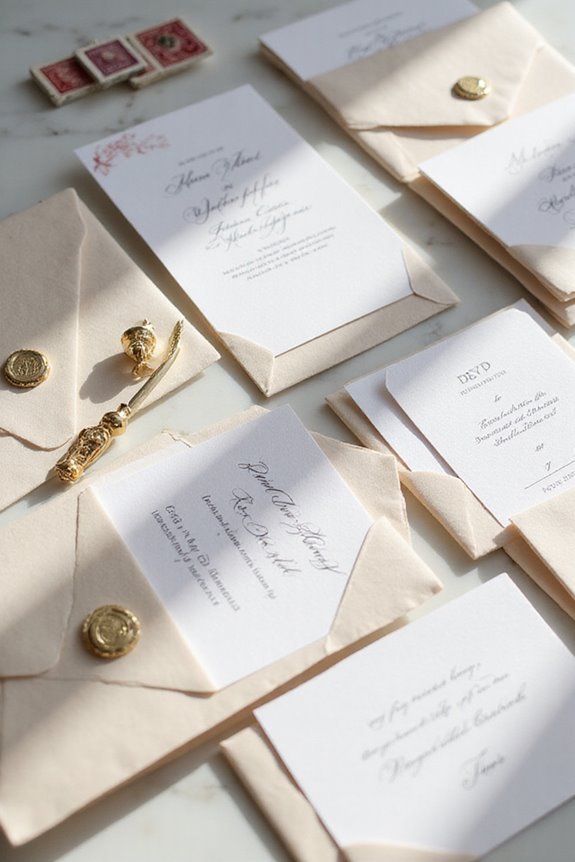
Getting those wedding invitations ready can feel like a monumental task, especially with so many steps involved. First, we’ll plunge into the design collaboration phase. This typically takes 2-6 weeks, where we discuss the wedding theme, style, and colors with our designer. If we want intricate touches like custom illustrations, it might take a bit longer.
Once we finalize the design, printing techniques come into play. This phase can also take 2-6 weeks, depending on the complexity of the invitations. Don’t forget, we need to allocate time for assembly and addressing envelopes, which can add another week or two. By planning ahead and allowing ample time for each step, we can guarantee our invitations are both beautiful and timely.
Importance of RSVP Timing
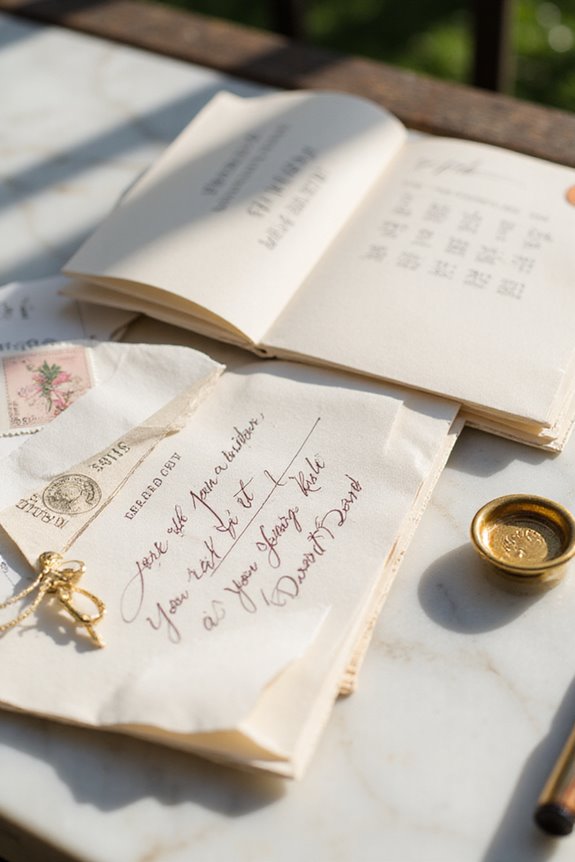
Understanding the importance of RSVP timing can really make a difference in how smoothly our wedding planning goes. Setting a clear RSVP deadline about four weeks before the big day creates RSVP clarity, allowing us to finalize arrangements without last-minute stress. We recognize that 57.6% of responses come in the first five weeks, so timing’s vital!
To boost response urgency, consider sending reminders a week before the deadline. This simple nudge helps guarantee we receive about 85% of RSVPs on time. Plus, offering multiple ways to respond—like online forms or traditional cards—makes it easier for our guests. Remember, a little clarity and urgency can go a long way in keeping our plans on track!
Factors Affecting Mail Delivery
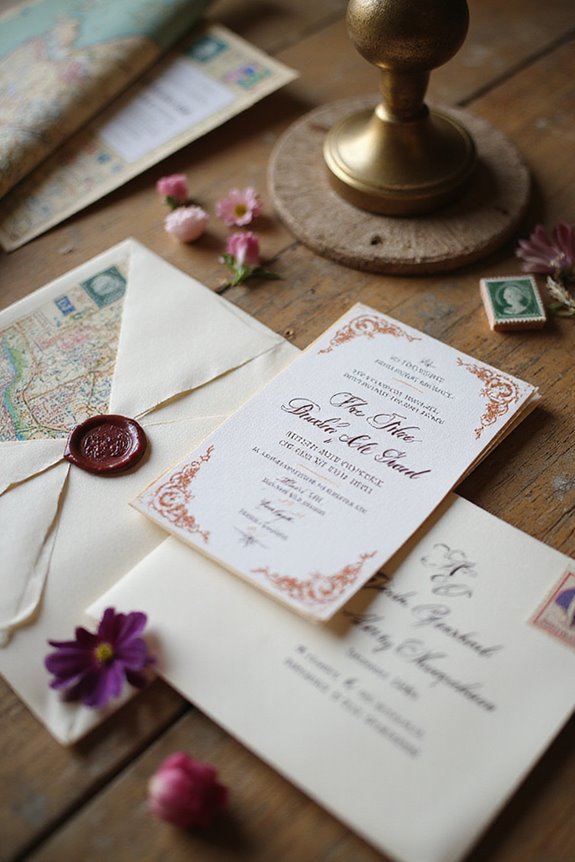
When it comes to mailing wedding invitations, a few factors can really impact how smoothly things go. First off, we need to take into account postal service delays. If we’re planning a destination wedding, mailing invitations 10 to 12 weeks ahead is essential for guest travel. For those of us in rural areas, rural logistics can be tricky too. Extra lead time is often necessary due to slower mail delivery.
Also, don’t forget the holiday season! If our wedding falls near significant holidays, let’s send those invites even earlier. Using priority mail can speed things up, especially when we want to make certain everyone gets their invite on time. With a little planning, we can make sure all our guests are informed and ready to celebrate!
Special Circumstances to Consider
Planning a wedding is no small feat, especially when you factor in special circumstances that can throw a wrench in our timeline. For destination weddings, we should send invitations 4 to 6 months ahead. This gives our guests enough time to book flights and accommodations—trust us, no one likes a last-minute scramble!
Now, if we’re getting married on holiday weekends, let’s consider sending those invites 8 to 10 weeks early. Guests often juggle holiday plans, and a little extra notice can make a big difference. Plus, accommodations fill up fast during peak times. By planning ahead, we help everyone feel included and avoid calendar conflicts. After all, we want our loved ones to celebrate with us, not stress about travel!
Tips for Managing Guest Responses
Managing guest responses can feel like a juggling act, especially as we inch closer to the big day. To boost our RSVP rates, let’s consider some RSVP incentives. Perhaps we could offer a fun prize through a drawing for those who respond early. Clear RSVP instructions and pre-addressed envelopes can also reduce any barriers.
Don’t forget about response reminders! A gentle nudge via text or email after the deadline can work wonders for those lagging behind. If we notice some guests still haven’t responded, personal follow-ups can really help. By staying organized and flexible, we can tackle any last-minute changes. Remember, a little humor can lighten the mood when asking our friends to confirm attendance!
Final Thoughts on Invitation Mailing
As we wrap up our thoughts on managing guest responses, it’s time to contemplate the final steps in mailing those invitations. We want to guarantee our invitation design reflects our vision while adhering to guest etiquette.
First, let’s mail local invitations 6 to 8 weeks ahead, and for destination weddings, aim for 10 to 12 weeks. Don’t forget to double-check addresses—nothing says “oops” like a returned invite! If it’s a busy season, consider sending invitations earlier to avoid conflicts.
Lastly, set clear RSVP deadlines, ideally 3 to 4 weeks before the big day. This way, we can plan seating charts without the last-minute scramble. Let’s embrace this process, and soon we’ll celebrate together with our favorite people!
Frequently Asked Questions
Can I Send Digital Invitations Instead of Traditional Ones?
Absolutely, we can send digital invitations instead of traditional ones! They offer benefits like cost savings and real-time RSVP tracking, but let’s remember traditional invitation etiquette—some guests might still expect formal paper invites.
What Should I Do if I Miss the Mailing Deadline?
If we’ve missed the mailing deadline, it’s like trying to catch a falling star! We can quickly pivot to digital invitations and enhance guest communication, ensuring everyone stays informed and excited despite the late invitations.
How Do I Address Invitations for Blended Families?
When addressing invitations for blended families, we should consider blended family dynamics and focus on invitation etiquette. Using inclusive phrases honors all family members, ensuring everyone feels recognized and valued in this special moment.
Is It Necessary to Include a Dress Code on Invitations?
We believe including a dress code on invitations highlights its significance in invitation etiquette. It helps guests feel confident about their attire, ensuring everyone’s comfortable and appropriately dressed for our special day.
What Information Should I Include on the RSVP Card?
When creating an RSVP card, let’s include RSVP deadlines and meal choices. We should also provide space for dietary restrictions and special requests, ensuring our guests feel welcomed and informed about their attendance.

